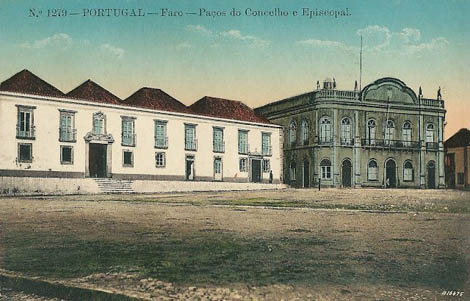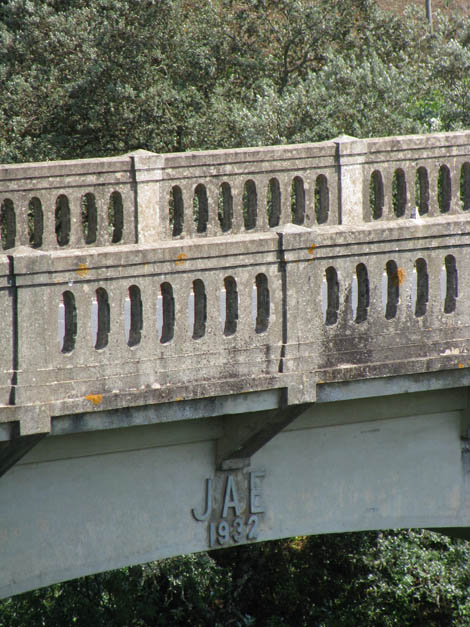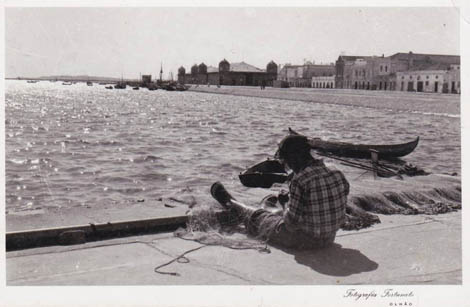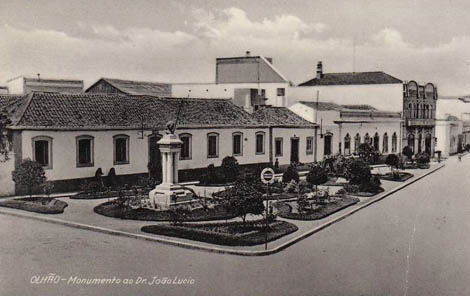 The first day of General Carmona's visit to the Algarve, 15 February 1932, culminated with a gala banquet, offered by the Algarve's municipalities, in the main hall of the Municipal Council of Faro, which 200 people attended.
The first day of General Carmona's visit to the Algarve, 15 February 1932, culminated with a gala banquet, offered by the Algarve's municipalities, in the main hall of the Municipal Council of Faro, which 200 people attended.
The room was brightly lit, and the table of honor was occupied in the center by the head of state, who had on his right the president of the Ministry, minister of commerce and bishop, and on his left, the minister of justice, the civil governor and the military commander of Faro. In front was the president of the Chamber of Faro, flanked by the ministers of War and the Navy, among other personalities.
In other places of honor, the commander of the Department, Eng. Poole da Costa, Ribeiro Castanho, the four decorated workers, representatives of all the Chambers of the region and of various economic bodies in the Algarve, also sat.
According to the newspaper “O Século”, “at the entrance of the Head of State, the “Portuguese” was performed by the orchestra, which during the banquet held a concert, which was broadcast by the TSF (...) On the building's steps, the guard of honor was made by the Volunteer Firefighters of Faro".
The speeches began by Mário Lyster Franco, president of the Faro local authority, who thanked the Algarve for the visit, then toasting “the personal prosperity of the Head of State, the Dictatorship, the Fatherland and the Republic”.
 This was followed by the civil governor, who pointed out that “the inauguration of the Roxo river bridge brought the Algarve to the end of isolation from the rest of the country, maintained over many years and thanks to the policy that has presided over the nation's destinies until the advent of the Dictatorship”.
This was followed by the civil governor, who pointed out that “the inauguration of the Roxo river bridge brought the Algarve to the end of isolation from the rest of the country, maintained over many years and thanks to the policy that has presided over the nation's destinies until the advent of the Dictatorship”.
As a result of the times, he also made some considerations about the Estado Novo, "because it should be the aspiration of all the Portuguese in favor of the pacification of the national family, but that should only be done when order is ensured to be strictly ensured".
His speech ended with a “salute to the absent government members, specializing in Mr. Dr. Oliveira Salazar [Minister of Finance] (great ovation), from whom he gave the highest praise, pointing out his qualities as a statesman. He ended with a "live" to free and independent Portugal."
He was succeeded by the chairman of the district commission of the União Nacional, Ramalho Ortigão, who made a diagnosis of the region, referring that “the Algarve is sick, the trade is impoverished, the industry is ruined, the agriculture is growing”, adding later the important works of the Dictatorship. and ending with declaiming “the last verses of a sonnet by the great poet Cândido Guerreiro”.
Finally, the head of State spoke, with the “Diário de Notícias” recording the moment: “Mr. President of the Republic, as always, said with all simplicity what he felt, just expressing his gratitude to the Algarve province, of which he has beautiful memories and where he was commanding the 4th military region. (…) he felt so much happier for having come to connect the south to the north, inaugurating the bridge at Aljustrel. He was moved and satisfied by feeling the happiness of the people of the region”.
Throughout the speech, he also stated that "it is necessary the concurrence of all Portuguese people to make the Estado Novo, being convinced that we are marching along a safe path to achieve patriotic ends".
Ending, after several thanks to the different entities present there, for “toasting to the happiness of the Algarve and the city of Faro".
“Enthusiastic cheers that drowned out the last words of the Head of State” echoed through the room.
The banquet ended with warm greetings, with the orchestra performing “A Portuguesa”.
The illustrious visitors then went to Club Farense, where a ball was held in their honor, at the end of which “they went on foot to his residence, having received much acclaim from the people during this journey”.
That night, “a dazzling firework” prepared by Algarvian and northern fireworks was also burned on the dock, which “was admired by a huge crowd that filled the city's streets”.
It should be remembered that at Praça D. Francisco Gomes there were four music bands and that the city was festively decorated and lit up.
 The following morning, with the objective of visiting the works of the bar, the president boarded the gunboat «Limpopo» on the wharf of Faro.
The following morning, with the objective of visiting the works of the bar, the president boarded the gunboat «Limpopo» on the wharf of Faro.
On the ship were all civil and military authorities, administrators of the district council, students and teachers from the Tomás Cabreira Industrial School, Liceu and many people.
According to “O Século”, when the “Head of State entered the longboat that took him aboard that war vessel, the ships anchored there [gunboat «Raúl Cascais» and tugboat «Lidador»] saved [with 21 shots] and their crews gave the regulatory "lives".
The flotilla then lifted anchor towards Olhão and, according to the DN, “during the enchanting journey, a dazzling aspect of the Algarve coast was enjoyed, whose beauty the beautiful day highlighted the most”.
Near Olhão, the distinguished visitors awaited “several fishing sieges of that village flanked by an arch, and many men and women were seen on board who were making an enthusiastic demonstration. The mermaids whistled festively”.
In front of the bar, the president and other ministers were informed of the state of the works by the engineers Poole da Costa and Abecassis. The Head of State during the trip “declared himself very touched by the reception and delighted with the beautiful aspect of the estuary, full of multicolored and decorated boats”.
On the Olhão pier, according to “O Século”, “the crowd was compact and, when the flotilla anchored, the steamers' sirens whistled for a long time, as did the village's factories. The visitors disembarked amidst all that noise, now heightened by the salute given by «Limpopo»”.
 On the pier, he was the president awaited by civil authorities, military, firefighters, school children, collectives and other entities, producing “at the moment of disembarkation a resounding demonstration. Rockets and mortars thundered constantly and church bells tolled. The boy Hélder Cavaco Azevedo offered the Head of State a bunch of flowers, on behalf of his fellow disciples at the Brancanes school, who threw many petals as the presidential procession passed”.
On the pier, he was the president awaited by civil authorities, military, firefighters, school children, collectives and other entities, producing “at the moment of disembarkation a resounding demonstration. Rockets and mortars thundered constantly and church bells tolled. The boy Hélder Cavaco Azevedo offered the Head of State a bunch of flowers, on behalf of his fellow disciples at the Brancanes school, who threw many petals as the presidential procession passed”.
Olhão offered a “surprising view with the quay and the village flagged”. “From the wharf to the opposite point of the town, the cars strolled over a veritable carpet of flowers and through the lanes of people, who let out 'lives'. Bedspreads hung from the windows and the ladies clapped and threw flowers. The procession of cars was advancing with difficulty and only after long minutes did it manage to reach the road to Tavira”.
In Praça João Lúcio, the head of State, “in farewell to the official authorities of the Republic, embraced mr. Mário Lyster Franco and other authorities”.
The trip was now going towards Tavira, with the people acclaiming the visitors in Luz. At 12:30 pm the presidential party entered the Algarve's Venice.
(Go on)
Read the 1st part of this article here: Read the 2st part of this article here: Read the 3st part of this article here: Read the 4st part of this article here:

Author Aurélio Nuno Cabrita is an environmental engineer and researcher of local and regional history


















Comments